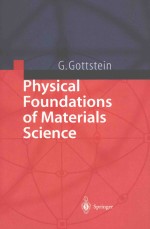

Physical foundations of materials sciencePDF电子书下载
- 电子书积分:16 积分如何计算积分?
- 作 者:Gu?nter Gottstein.
- 出 版 社:Springer
- 出版年份:2004
- ISBN:3540401393
- 页数:502 页
Introduction 3
1 Microstructure 5
2 Atomic Structure of Solids 13
2.1 Atomic Bonding 13
2.2 Crystal Structure 20
2.2.1 Crystal Systems and Space Lattice 20
2.2.2 Crystal Structures of Metals 24
2.2.3 Crystal Structure of Ceramic Materials 30
2.2.4 Crystal Structure of Plymers 32
2.3 Indexing Crystallographic Planes and Directions 35
2.4 Representation of Orientations:Stereographic Projection 41
2.5 Experimental Crystallographic Methods 45
2.5.1 Bragg’s law 45
2.5.2 X-ray Methods 46
2.5.3 Electron Microscopy 53
2.5.4 Crystallographic Textures 55
3 Crystal Defects 63
3.1 Overview 63
3.2 Point Defects 63
3.2.1 Types of point defects 63
3.2.2 Thermodynamics of point defects 65
3.2.3 Experimental evidence of point defects 68
3.3 Dislocations 71
3.3.1 Geometry of dislocations 71
3.3.2 Evidence of dislocations 78
3.4 Grain Boundaries 82
3.4.1 Terminology and Definitions 82
3.4.2 Atomic Structure of Grain Boundaries 84
3.4.2.1 Low angle grain boundaries 84
3.4.2.2 High angle grain boundaries 87
3.5 Phase Boundaries 98
3.5.1 Classification of Phase Boundaries 98
3.5.2 Phenomenological Characterization of Phase Boundaries 102
4 Alloys 107
4.1 Constitution of Alloys 107
4.2 Thermodynamics of Alloys 121
4.3 Solid Solutions 125
4.4 Intermetallic Compounds 133
4.4.1 Overview 133
4.4.2 Ordered Solid Solutions 134
4.4.3 Compound Phases 142
4.4.4 Phases with High Packing Density 144
4.4.5 Electronic Phases (Hume-Rothery-phases) 148
4.5 Multicomponent Systems 151
5 Diffusion 155
5.1 Phenomenology and Basic Laws 155
5.2 The Diffusion Constant 162
5.3 Atomistics of Solid State Diffusion 165
5.4 Correlation Effects 176
5.5 Chemical Diffusion 179
5.6 Thermodynamic factor 183
5.7 Grain Boundary Diffusion 186
5.8 Diffusion in Nonmetals:Ionic Conductors 190
6 Mechanical Properties 197
6.1 Basic Elements of Elasticity 197
6.2 The Flow Curve 202
6.3 Mechanisms of Plastic Deformation 210
6.3.1 Crystallographic Slip by Dislocation Motion 210
6.3.2 Mechanical Twinning 220
6.4 The Critical Resolved Shear Stress 226
6.4.1 Schmid’s Law 226
6.4.2 Dislocation Model of the Critically Resolved Shear Stress 230
6.4.2.1 Elastic Properties of Dislocations 230
6.4.2.2 Interaction of dislocations 235
6.4.3 Thermally Activated Dislocation Motion 237
6.5 Strain Hardening of fcc Single Crystals 241
6.5.1 Geometry of Deformation 241
6.5.2 Dislocation Models of Strain Hardening 245
6.5.3 Dissociation of Dislocations 252
6.6 Strength and Deformation of Polycrystals 257
6.7 Strengthening Mechanisms 264
6.7.1 Solid Solution Hardening 264
6.7.2 Dispersion Hardening 271
6.7.3 Precipitation Hardening 274
6.8 Time Dependent Deformation 278
6.8.1 Strain Rate Sensitivity of Flow Stress:Superplasticity 278
6.8.2 Creep 281
6.8.3 Anelasticity and Viscoelasticity 288
7 Recovery,Recrystallization,Grain Growth 303
7.1 Phenomena and Terminology 303
7.2 Energetics of Recrystallization 308
7.3 Deformation Microstructure 312
7.4 Recovery 316
7.5 Nucleation 321
7.6 Grain Boundary Migration 327
7.7 Kinetics of Primary Recrystallization 330
7.8 The Recrystallization Diagram 335
7.9 Recrystallization in Homogeneous Alloys 337
7.10 Recrystallization in Multiphase Alloys 338
7.11 Normal Grain Growth 341
7.12 Discontinuous Grain Growth (Secondary Recrystallization) 347
7.13 Dynamic Recrystallization 348
7.14 Recrystallization Textures 350
7.15 Recrystallization in Nonmetallic Materials 356
8 Solidification 357
8.1 The liquid state 357
8.2 Nucleation of the Solid State 360
8.3 Crystal Growth 367
8.3.1 Shape of a crystal 367
8.3.2 Atomistics of Crystal Growth 369
8.3.3 Crystal growth in the melt 371
8.3.3.1 Solidification of pure metals 371
8.3.3.2 Solidification of alloys 373
8.3.3.3 Solidification of eutectic alloys 376
8.4 Microstructure of a Cast Ingot 378
8.5 Solidification Defects 380
8.6 Rapid Solidification of Metals and Alloys 382
8.7 Solidification of Glasses and Polymers 385
8.7.1 Ionic crystals and glasses 385
8.7.2 Polymers 386
9 Solid State Phase Transformations 389
9.1 Pure Metals 389
9.2 Alloys 389
9.2.1 Diffusion Controlled Phase Transformations 389
9.2.1.1 General classification 389
9.2.1.2 Thermodynamics of decomposition 390
9.2.1.3 Nucleation and spinodal decomposition 396
9.2.1.4 Metastable phases 401
9.2.1.5 Age hardening 403
9.2.1.6 Growth kinetics of precipitates 407
9.2.1.7 Eutectoid decomposition and discontinuous precipitation 411
9.2.2 Martensitic Transformations 413
9.2.3 Applications 419
9.2.3.1 TTT diagrams 419
9.2.3.2 Technological importance of martensite transformations:some examples 419
10 Physical Properties 423
10.1 Fundamentals of Electron Theory 423
10.2 Mechanical and Thermal Properties 430
10.3 Thermal Conductivity 436
10.4 Electrical Properties 439
10.4.1 Conductors,semi-conductors and insulators 439
10.4.2 Conductivity of metals 443
10.4.3 Modeling of the Electrical Conductivity 446
10.4.4 Superconductivity 452
10.5 Magnetic Properties 457
10.5.1 Dia- and paramagnetism 457
10.5.2 Ferromagnetism 459
10.6 Optical Properties 466
10.6.1 Light 466
10.6.2 Reflection of metallic surfaces 468
10.6.3 Insulators 468
10.6.3.1 Color 468
10.6.3.2 Absorption 470
10.6.3.3 Photoconductivity 471
10.6.3.4 Luminescence 472
10.6.4 Applications 473
References 475
Specific Literature 483
Index 487
- 《共焦显微术的三维成像原理》(澳)M.顾(Min Gu)著;王桂英等译 2000
- 《Suite Opus 34 für Floete und Klavier》Charles-Marie Widor;Herausgegeben von/Edited by Ernst-Günter Heinemann; Fingersatz der Klavierstimme von/Fingering of piano part by Klaus Schilde 2014
- 《Bioinspired and biomimetic polymer systems for drug and gene delivery》Zhongwei Gu 2015
- 《Robot development using Microsoft Robotics Developer Studio》Shih-Chung Kang and wei-tze chang and kai-yuan gu and hung-lin chi 2011
- 《finite element language and its applications Ⅱ=有限元语言及应用 Ⅱ》liang guoping(梁国平)and zhou yongfa(周永发)and translated by gu guan(古泉译) 2015
- 《RECRYSTALLIZATION AND GRAIN GROWTH VOLUME TWO》GUNTER GOTTSTEIN AND DMITRI A.MOLODOV 2001
- 《CHINESE ACADEMY OF MEDICAL SCIENCES AND PEKING UNION MEDICAL COLLEGE 1988 YEARBOOK》GU FANGZHOU 1988
- 《Physical foundations of materials science》Gu?nter Gottstein. 2004
- 《ENVIRONMENTAL MICROBIOLOGY SECOND EDITION》RALPH MITCHELL AND JI-DONG GU 2010
- 《finite element language and its applications Ⅰ=有限元语言及应用 Ⅰ》liang guoping(梁国平)and zhou yongfa(周永发)and translated by gu guan(古泉译) 2015
